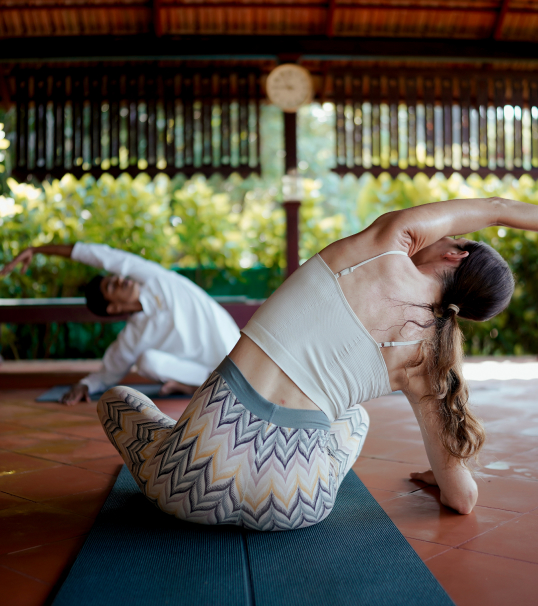At Rockholm, the crash of the waves, the sea-salt air, and the endless blue horizon conspire to create the ideal ambiance for pranayama - the timeless yogic practice of mindful breathing. On the coast, every breath is cleaner, and each exhalation releases tension, so that pranayama is intensely restorative.
Pranayama exercises are commonly divided into three categories: balancing, heating, and cooling. They each have a different function, and taken together, they form a whole practice for relaxation, energy, and inner balance.
These exercises balance body and mind, stabilize emotions, and induce profound calm.

How to practice: Sit comfortably with the spine erect. Use the right hand - close the right nostril with the thumb, slowly inhale through the left. Close the left nostril with the ring finger, exhale through the right. Then inhale through the right, exhale through the left. That is one round. Practice for 5–10 rounds.
Benefits: Balances the nervous system, cleanses energy channels, calms stress, and clarifies concentration.
How to practice: Slowly inhale and exhale through the nose while slowly constricting the throat, making a soft ocean sound. Hold the breath long, smooth, and steady.
Benefits: Triggers relaxation, enhances lung capacity, facilitates meditation, and imitates the sound of sea waves, promoting relaxation.
How to practice: Close the eyes, put the fingers on the ears lightly. Breathe in slowly and breathe out slowly making a soft humming bee-like sound.
Benefits: Eases anxiety, calms mental chatter, and produces relaxing vibrations that soothe the nervous system.
How to practice: Breathe first into the belly, then into the ribs, and finally into the chest. Slowly exhale in the opposite order - chest, ribs, belly. Practice with awareness for a few minutes.
Benefits: Opens up the lung capacity, invites mindful breathing, relaxes tension, and promotes deep relaxation.
How to practice: Sit in stillness, breathe slowly, and listen to the fine inner sound produced by the breath. Let awareness settle in the vibration and resonance within.
Benefits: Creates calmness, synchronizes inner energy, and links breath with subtle sound for meditative alertness.
They generate heat, energy, and vitality—ideal for invigorating seashore mornings.
How to do it: Sit with an erect back. Breathe normally while inhaling and strongly exhale by tightening the abdominal muscles; the inhalation occurs involuntarily. Practice 20–30 strokes and then rest and breathe normally
Benefits: Purifies the lungs, aids digestion, energizes the body, and dispels mental cloudiness.
How to practice: Make strong, slow inhalations and exhalations through the nose, with the chest and shoulders relaxed. Practice for 10–15 breaths, and then rest.
Benefits: It increases circulation, invigorates the body, heats the body, and stimulates energy.
Cooling pranayamas cool the body and confer tranquility - particularly soothing in hot tropical climates near the ocean.
How to practice: Curl the tongue into a tube (if possible), breathe in slowly through it, and breathe out softly through the nostrils. Benefits: It cools the body, calms the mind, and calms anger or restlessness.
How to practice: Bring the teeth lightly together, slightly open the lips apart, and breathe in through the spaces between the teeth with a soft hissing sound. Breathe out through the nose.
Benefits: Cools the system, refreshes the body, and steadies the mind.
How to practice: Relax the teeth slightly together and breathe in through the tiny openings between the teeth, exhaling slowly out the nose.
Benefits: Lowers inner heat, calms the nervous system, and creates a feeling of balance and clarity.
By the sea, pranayama is not just a breathing technique - it's an exchange with nature. The waves' rhythm echoes Ujjayi breathing, the sea air amplifies cooling exercises, and the open horizon encourages balance and calm. Many visitors comment that their pranayama exercise at Rockholm is easier, more earthy, and profoundly nourishing.
Whether it's balance, aliveness, or chilled-out calm you're looking for, seafront pranayama is an authentic means to connect back into yourself and truly relax.
1. What is the best time of day to practice pranayama by the sea?
Morning is ideal, as the air is fresh and the mind is calm. However, gentle pranayamas like Nadi Shodhana and Dirgha can also be practiced in the evening for relaxation.
2. Can beginners practice these pranayamas at Rockholm?
Yes. All pranayamas taught at Rockholm are guided step-by-step by experienced teachers, making them accessible for both beginners and seasoned practitioners.
3. How long should each pranayama session last?
Even 10–15 minutes can make a difference. With regular practice, guests may extend sessions to 20–30 minutes under guidance.
4. Are there any precautions I should take before practicing pranayama?
Yes. It is best practiced on an empty stomach or at least 2 hours after meals. Those with health conditions (like high blood pressure or pregnancy) should avoid certain heating pranayamas such as Kapalabhathi and Basthrika.
5. How does practicing pranayama by the sea enhance the experience?
The ocean air is rich in prana (life energy). The sound of the waves supports rhythm in breathing, while the natural setting encourages deeper relaxation and mindfulness.